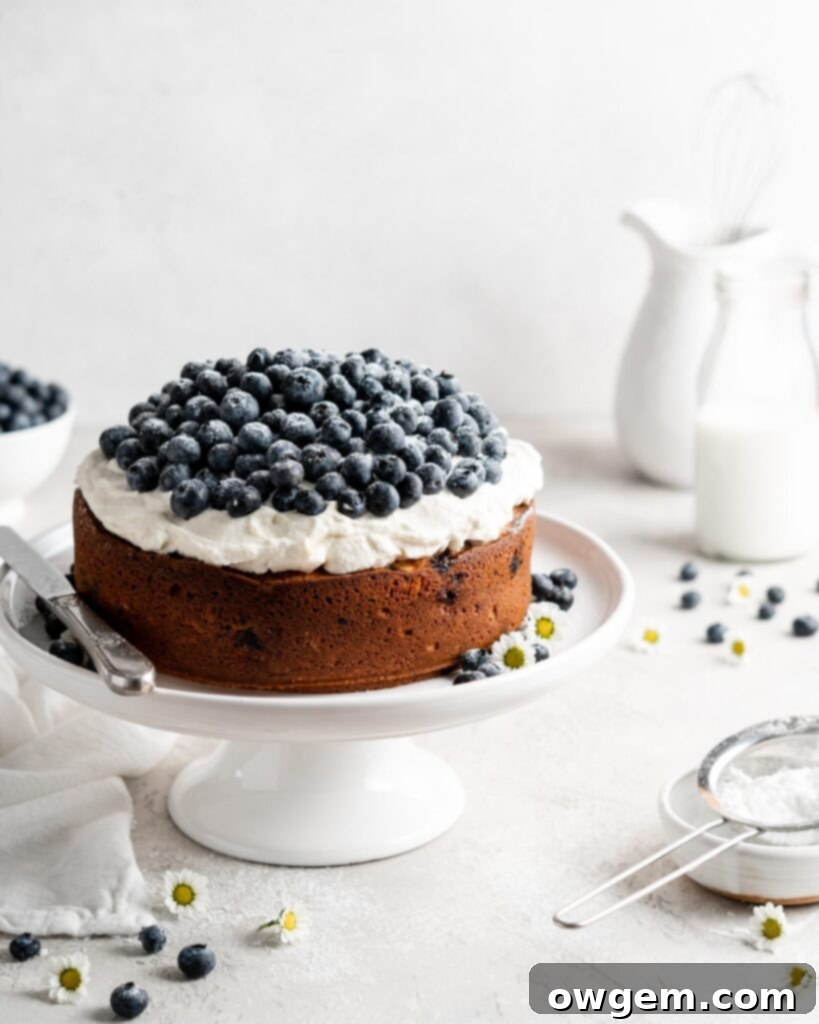Fluffy Blueberry Elderflower Cake with Mascarpone Whipped Cream: Your Perfect Spring Dessert
Indulge in the enchanting flavors of spring with this exquisite single-layer Blueberry Elderflower Cake. This recipe delivers a cake that is remarkably fluffy and tender, bursting with the sweet, vibrant taste of fresh blueberries, elegantly complemented by a delicate hint of floral elderflower. Each slice promises a delightful experience, thanks to an abundance of juicy blueberries generously distributed throughout the batter and a luxurious topping of creamy, subtly sweet mascarpone whipped cream. This cake is not just a dessert; it’s a celebration of seasonal bounty and refined taste, perfect for any special occasion or a delightful afternoon treat.
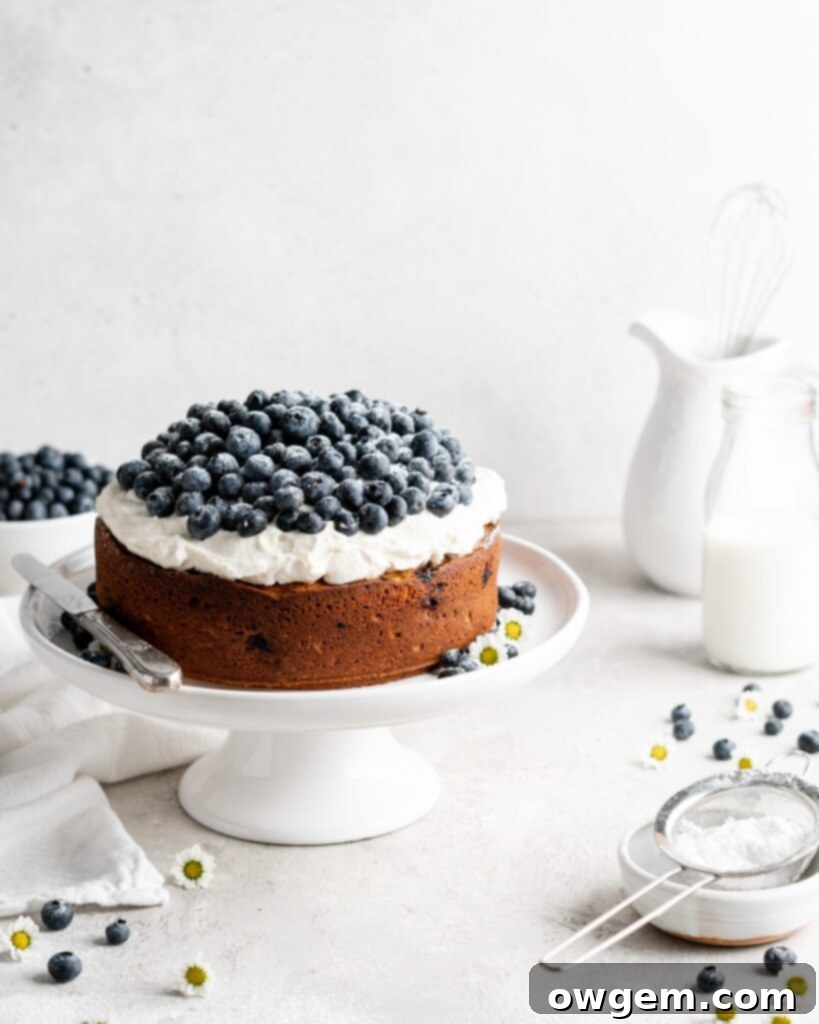
Mastering Blueberries: Fresh vs. Frozen in Baking
As spring blossoms and summer approaches, blueberries come into their peak season, making it the ideal time to incorporate these succulent, sweet berries into your baking. Using fresh blueberries not only enhances the flavor profile of your cake but also provides a superior texture. However, we understand that fresh blueberries aren’t always available year-round. Many bakers often resort to frozen blueberries when fresh ones are out of season or too expensive. If you’ve ever used frozen blueberries in a cake, muffin, or cupcake batter, you might have encountered a common baking dilemma: your entire baked good turning an unappetizing shade of blue or even green! This color bleed is due to the anthocyanin pigments in blueberries, which are released when the berries thaw and their cell walls break down, allowing the colored juice to seep into the surrounding batter.
Fortunately, there’s a straightforward and highly effective solution to prevent this vibrant discoloration: thoroughly rinsing your frozen blueberries! This essential step helps remove the excess juice that naturally surrounds the berries, ensuring that this concentrated liquid doesn’t leach into your delicate cake batter. The rinsing process isn’t a quick splash; it requires patience. You need to rinse the frozen berries under cool running water until the water draining from them runs almost completely clear. This thorough rinse effectively washes away the free-floating pigments. After this careful process, your frozen blueberries will be perfectly prepped and ready to use, behaving much like fresh blueberries in your batter without the risk of dyeing your beautiful blueberry elderflower cake an unexpected hue. For an extra layer of protection, you can also gently toss the rinsed (and lightly patted dry) frozen blueberries with a tablespoon of flour before folding them into the batter. This light flour coating acts as a barrier, further minimizing any potential color bleed and ensuring the berries are evenly suspended throughout the cake.
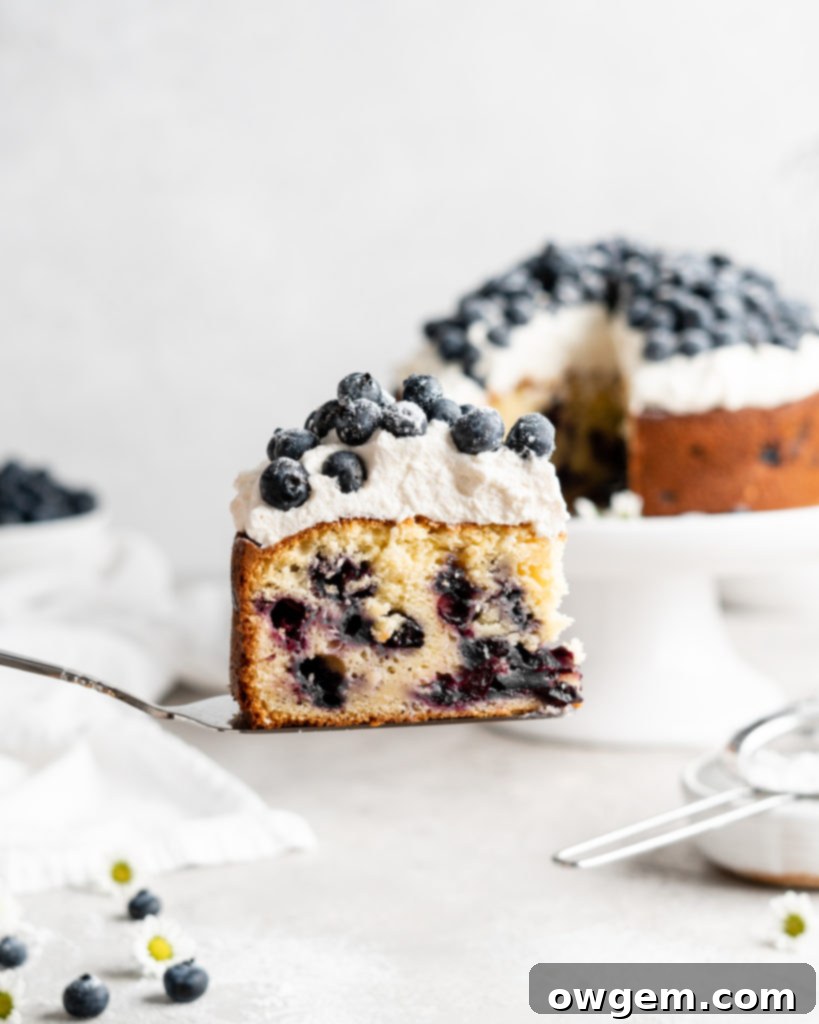
Crafting Your Delightful Blueberry Elderflower Cake: A Step-by-Step Guide
Creating this single-layer Blueberry Elderflower Cake is a rewarding experience, yielding a dessert that looks as impressive as it tastes. Follow these detailed steps to ensure a perfectly baked, flavorful cake:
1. Beat Eggs and Sugar to Perfection: Begin by adding the large eggs, the fragrant lemon-zest infused sugar, delicate elderflower liqueur, and rich vanilla extract to the bowl of your stand mixer. With the paddle attachment, beat these ingredients together on high speed for approximately 3-4 minutes. The goal here is to incorporate a significant amount of air, transforming the mixture into a light, fluffy, and voluminous consistency, ideally tripled in volume. This step is crucial for achieving the cake’s signature tender and airy crumb.
2. Gradually Incorporate Melted Butter: Once your egg mixture is light and airy, reduce the stand mixer speed to medium. Slowly and steadily drizzle the melted, slightly cooled butter into the bowl while the mixer continues to run. This slow addition helps to emulsify the butter into the egg mixture, ensuring a smooth and homogenous batter. After all the butter has been added, continue beating the mixture for an additional 30 seconds to fully combine everything.
3. Whisk Together the Dry Ingredients: In a separate, medium-sized mixing bowl, combine the all-purpose flour, baking powder, and salt. Whisk these dry ingredients thoroughly until they are well combined. This ensures that the leavening agents and salt are evenly distributed throughout the flour, which is vital for an even rise and consistent flavor in your cake.
4. Alternate Adding Dry and Wet Ingredients: Now, it’s time to combine the wet and dry mixtures. With the stand mixer on a low speed, begin by adding one-third of the whisked dry ingredients to the wet mixture, beating only until just combined. Then, add half of the full-fat sour cream, and again, beat until just incorporated. Continue this alternating pattern, adding the remaining dry and wet ingredients in this order, always finishing with the dry ingredients. This method helps to prevent overmixing the batter, which can lead to a tough cake. Finally, gently fold in the fresh (or properly rinsed frozen) blueberries using a spatula. Be careful not to overmix, as this can crush the berries and distribute their color prematurely.
5. Prepare for Baking: Carefully pour the prepared blueberry elderflower cake batter into your greased and floured 9-inch springform cake pan, or a pan lined with parchment paper. Place the pan into the preheated oven and bake according to the recipe instructions. Baking times can vary slightly depending on your oven, so keep an eye on it. The cake is done when a wooden skewer or toothpick inserted into the center comes out clean. Once baked, allow the cake to cool completely in the pan on a wire rack before attempting to remove it or apply any topping. Cooling thoroughly is essential to prevent the cake from breaking and to ensure the mascarpone whipped cream topping adheres properly.
Preventing the Dreaded Soggy Bottom: A Baker’s Secret
One of the most common frustrations when baking cakes or other treats with blueberries is discovering that all those delicious berries have sunk to the bottom of the pan during baking. This often results in a dense, sometimes soggy, and heavily blueberry-laden cake bottom, leaving the top half of your cake relatively bare. The reason for this phenomenon is simple: blueberries are denser than cake batter, and as the batter heats and thins, gravity pulls the berries downward. While a bit of sinking is natural, a completely soggy bottom can detract from the overall enjoyment of your cake.
Thankfully, there’s a brilliantly simple yet incredibly effective trick to prevent this from happening! The secret lies in creating a “cushion” of blueberry-free batter at the base of your cake. Before you fold the blueberries into the entire cake batter mixture, scoop out about a quarter to a third of the plain batter and spread it evenly into the bottom of your prepared cake pan. This forms a foundational layer. Once this base is in place, you can then gently fold the blueberries into the remaining batter and pour it over the plain layer in the pan. This technique ensures that even if some berries decide to sink, they will only reach this plain batter layer, preventing them from compacting at the very bottom of the pan and creating that undesirable soggy texture. It’s a small adjustment that makes a significant difference in achieving a perfectly uniform and delightfully textured blueberry cake.

Discovering Mascarpone: The Creamy Italian Secret
Mascarpone is a luxurious Italian dairy product, often described as a type of cream cheese, but with distinct characteristics that set it apart. Originating from the Lombardy region of Italy, mascarpone is renowned for its incredibly smooth, velvety texture, reminiscent of a rich, thick cream. Unlike traditional American cream cheese, which typically has a tangy, slightly acidic flavor, mascarpone boasts a much more neutral, subtly sweet taste. This milder flavor profile allows it to beautifully complement other ingredients without overpowering them, making it a versatile component in both sweet and savory dishes.
What truly defines mascarpone is its exceptionally high butterfat content. This elevated fat level is responsible for its signature creamy, almost buttery texture and rich mouthfeel. It’s this luxurious quality that makes mascarpone so desirable in desserts like tiramisu, and, as you’ll discover, in this Blueberry Elderflower Cake recipe. Here, mascarpone plays a critical role when combined with whipped cream to create a stable and delectable topping. Whipped cream, while delicious, is notoriously fragile. On its own, it can begin to “weep” or lose its elegant shape and structure relatively quickly, especially when exposed to room temperature. This is where mascarpone truly shines. It acts as an indispensable stabilizer for the whipped cream, lending it structure, body, and remarkable longevity. By incorporating mascarpone, the whipped cream maintains its peaks and creamy consistency for much longer, ensuring your cake looks and tastes fantastic for hours after assembly. It’s the perfect “friend” for whipped cream, keeping it rigid and in shape, ready to adorn your beautiful cake.
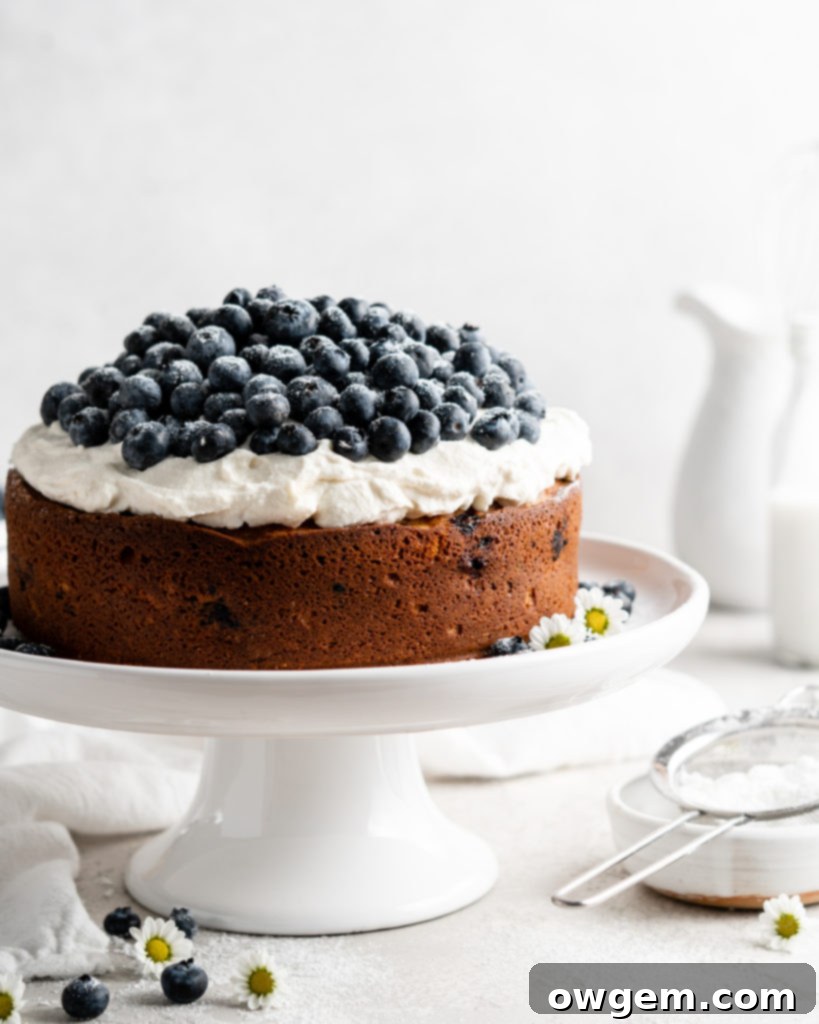
Creating the Velvety Mascarpone Whipped Cream Topping
The exquisite mascarpone whipped cream topping is the crowning glory of this Blueberry Elderflower Cake, adding a layer of creamy richness and delicate sweetness. To achieve the perfect consistency, there are a couple of crucial points to remember. First and foremost, the mascarpone cheese absolutely needs to be well-softened and at room temperature before you begin. Cold mascarpone will remain firm and chunky, refusing to blend smoothly into the light, airy whipped cream, resulting in a lumpy and uneven texture. Plan ahead and take it out of the refrigerator at least 30-60 minutes before you start.
To prepare this divine topping for your blueberry elderflower cake, start by pouring the well-chilled heavy cream into the bowl of a stand mixer fitted with a whisk attachment. Add the confectioners’ sugar and vanilla extract to the bowl. Begin beating the mixture on high speed. Continue to whip until the cream reaches stiff peaks – this means when you lift the whisk, the peaks hold their shape firmly and don’t flop over. Be careful not to over-whip at this stage, as heavy cream can quickly turn grainy or even into butter if beaten too long. Once stiff peaks are achieved, add the softened, room-temperature mascarpone cheese to the bowl. Reduce the mixer speed to medium-low and continue beating just until the mascarpone is thoroughly incorporated, and the texture becomes smooth and silky. Over-beating after the mascarpone is added can also lead to a curdled texture, so mix just until combined and smooth.
It is important to note that once the mascarpone whipped cream is added to your cake, the entire dessert needs to be refrigerated promptly. Despite the stabilizing properties of mascarpone, whipped cream remains highly sensitive to heat. Even moderate warmth can cause it to lose its structure and melt very quickly. Storing the cake in the refrigerator will maintain the cream’s beautiful texture and freshness, ensuring every slice is as delightful as the first. This delicate topping transforms the simple blueberry cake into an elegant and unforgettable dessert experience.
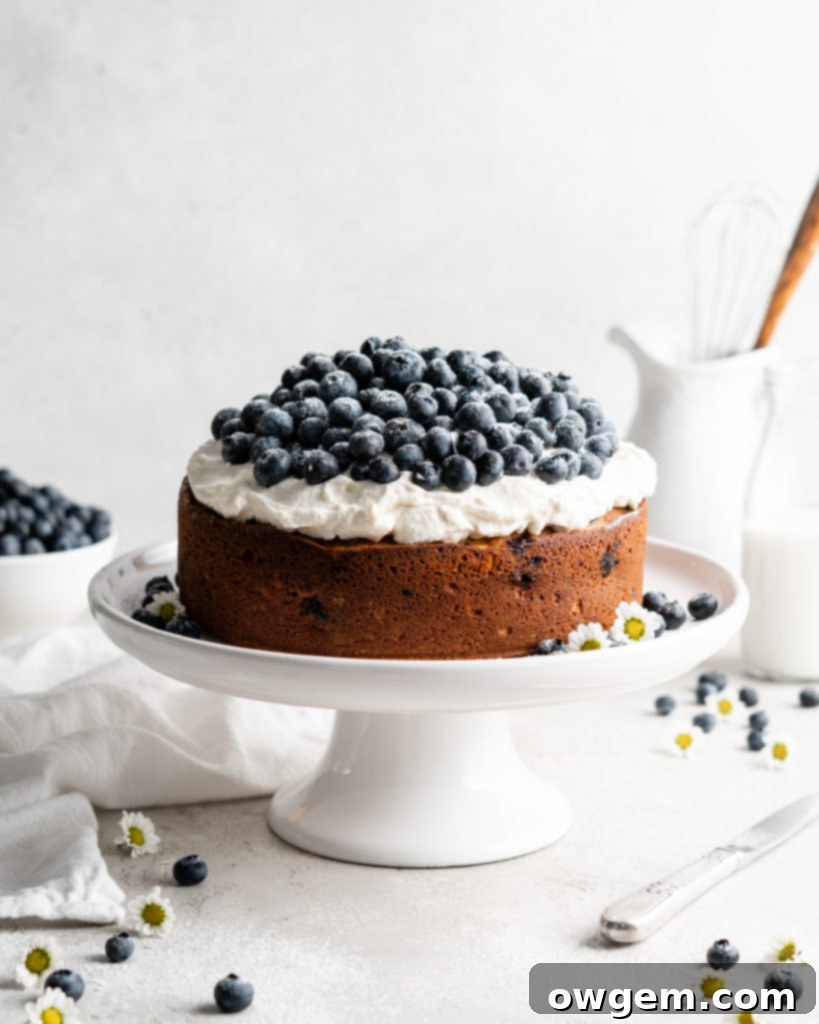
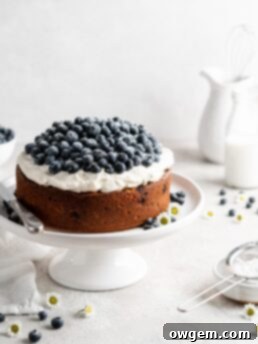
Get the Recipe:
Blueberry Elderflower Cake
Pin
Rate
Ingredients
Blueberry Elderflower Cake
- 2 ¼ cups (270g) All Purpose Flour,, measured correctly
- 1 ½ tsp Baking Powder
- ½ tsp Salt
- 1 ½ cups (300g) White Sugar
- Zest of 1 Lemon
- 3 Large Eggs,, at room temperature
- 2 tbsp Elderflower Liqueur
- 2 tsp Vanilla
- 1 cup (227g) Unsalted Butter,, melted
- 1 cup (240g) Full Fat Sour Cream
- 2 cups (380g) Blueberries,, divided
Mascarpone Whipped Cream
- 1 ¼ cups (300g) Heavy Cream,, well chilled
- 1/2 cup (60g) Confectioners Sugar
- 1 tsp Vanilla
- 6 oz (170g) High Quality Mascarpone Cheese,, at room temperature
Equipment
-
Stand mixer
Instructions
Blueberry Elderflower Cake
-
Preheat your oven to 350°F (175°C). Prepare a 9-inch springform cake pan by lightly coating it with cooking spray and lining the bottom with a parchment paper round. In a medium to large-sized mixing bowl, combine the all-purpose flour, baking powder, and salt. Whisk these dry ingredients together thoroughly to ensure even distribution.
-
In a separate small bowl, combine the lemon zest and white sugar. Using your fingertips, rub the lemon zest into the sugar for about 1-2 minutes until the sugar becomes very fragrant and infused with citrus oils. This step enhances the lemon flavor significantly.
-
In the bowl of a stand mixer fitted with the paddle attachment, add the room-temperature eggs, the lemon zest-infused sugar, elderflower liqueur, and vanilla extract. Beat these ingredients on high speed for approximately 5 minutes. The mixture should transform into a thick, pale, and fluffy consistency, nearly tripling in volume as air is incorporated. Then, with the mixer speed reduced to medium-low, slowly drizzle in the melted unsalted butter. Continue beating for an additional minute after all the butter has been added to ensure it’s fully emulsified into the batter.
-
Reduce the mixer speed to its lowest setting. Add the whisked dry mixture to the stand mixer in three alternating additions with the full-fat sour cream. Begin by adding one-third of the dry ingredients, beat until just combined, then add half of the sour cream, beat until just combined, and repeat, finishing with the final third of the dry ingredients. Beat only until the batter is smooth and no streaks of flour remain, being careful not to overmix. Finally, gently fold in 1 cup (190g) of the prepared blueberries using a spatula.
-
Pour the cake batter into the prepared 9-inch pan. Bake in the preheated oven for approximately 50 to 60 minutes, or until a wooden skewer or toothpick inserted into the center of the cake comes out clean. If the top browns too quickly, you can loosely tent it with aluminum foil. Once baked, remove the cake from the oven and allow it to cool completely on a wire rack before attempting to remove it from the pan or applying any topping. This ensures the cake’s structural integrity.
Mascarpone Whipped Cream
-
In the bowl of a stand mixer fitted with the whisk attachment, combine the well-chilled heavy cream, confectioners’ sugar, and vanilla extract. Beat on high speed until the mixture reaches just before stiff peaks form. The cream should be thick and hold its shape but still be slightly soft. Add the room-temperature mascarpone cheese to the bowl. Continue to beat on medium-high speed until the mascarpone is thoroughly combined, and the cream forms firm, stiff peaks. Be careful not to over-whip, which can make the texture grainy.
-
Once the cake has completely cooled, generously dollop the mascarpone whipped cream on top, spreading it evenly across the surface. Then, artfully arrange the remaining 1 cup (190g) of fresh blueberries over the cream. For a final elegant touch, lightly dust the cake with additional confectioners’ sugar just before serving.
-
To maintain its freshness and the stability of the whipped cream, any leftover or prepared cake with the mascarpone topping should be stored in the refrigerator if not consuming immediately. It is best enjoyed within 2-3 days.

